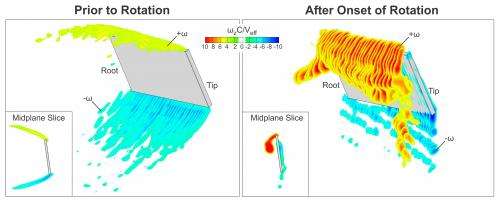New experiments offer insight into how insects fly and how to design tiny flying robots

Researchers have identified some of the underlying physics that may explain how insects can so quickly recover from a stall in midflight—unlike conventional fixed wing aircraft, where a stalled state often leads to a crash landing.
The analysis, in which the researchers studied the flow around a rotating model wing, improves the understanding of how insects fly and informs the design of small flying robots built for intelligence gathering, surveillance, search-and-rescue, and other purposes. The work is described in the journal Physics of Fluids.
An insect such as a fruit fly hovers in the air by flapping its wings—a complex motion akin to the freestyle stroke in swimming. The wing rotates in a single plane, and by varying the angle between the plane and its body, the insect can fly forward from a hovering position.
To simulate the basics of this action, Matthew Bross and colleagues at Lehigh University in Bethlehem, PA, studied how water flows around a rotating model wing consisting of a rectangular piece of acrylic that is twice as long as it is wide. The rotation axis is off to the side of the wing and parallel to its width, so that it rotates like half of an airplane propeller. To simulate forward motion—a scenario in which the insect is accelerating or climbing—the researchers pumped water in the direction perpendicular to the plane of rotation.
"We were able to identify the development of flow structure over an insect-scaled wing over a range of forward flight velocities," Bross explained. The researchers made detailed three-dimensional computer visualizations of the flow around the wing, finding that a leading-edge vortex—a feature crucial for providing lift—almost immediately appears once the wing starts to rotate after a stalled state.
More information: The article, "Flow structure on a rotating wing: effect of steady incident flow," by Matthew Bross, Cem Alper Ozen and Donald Rockwell appears in the journal Physics of Fluids: dx.doi.org/10.1063/1.4816632
Journal information: Physics of Fluids
Provided by American Institute of Physics




















